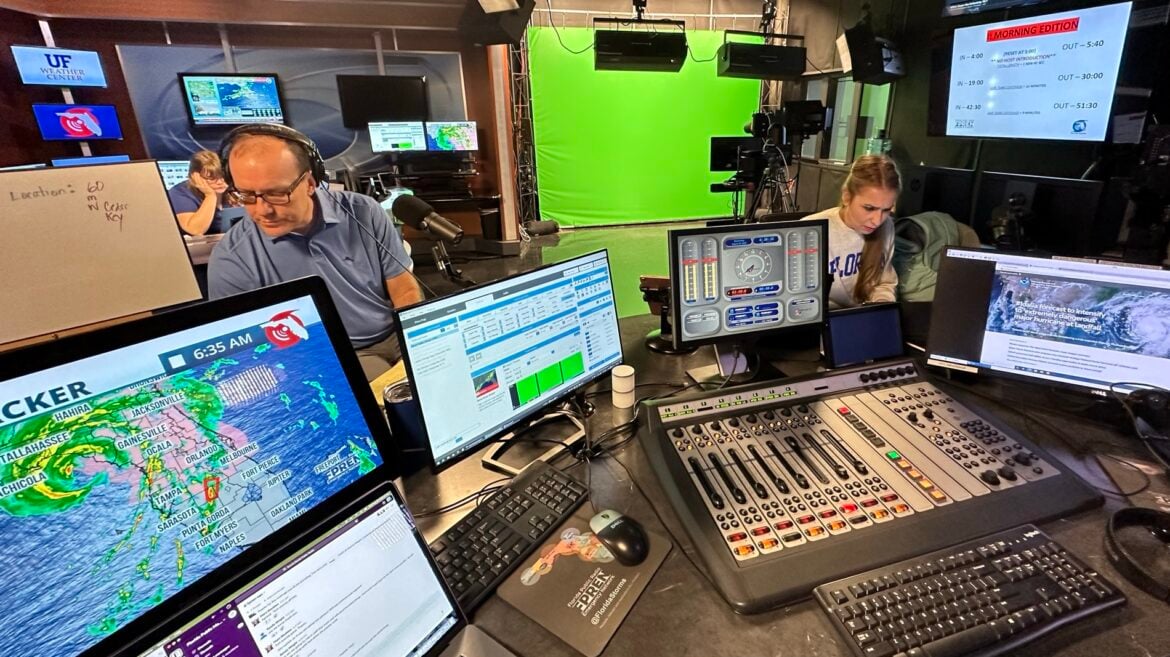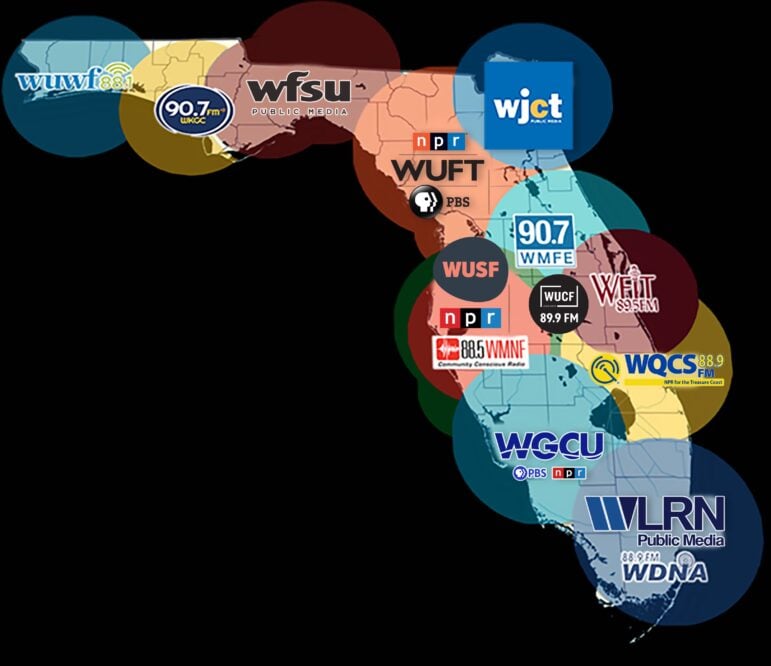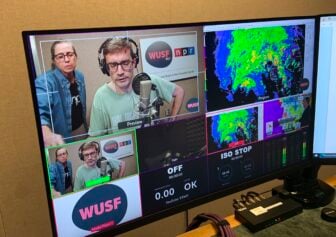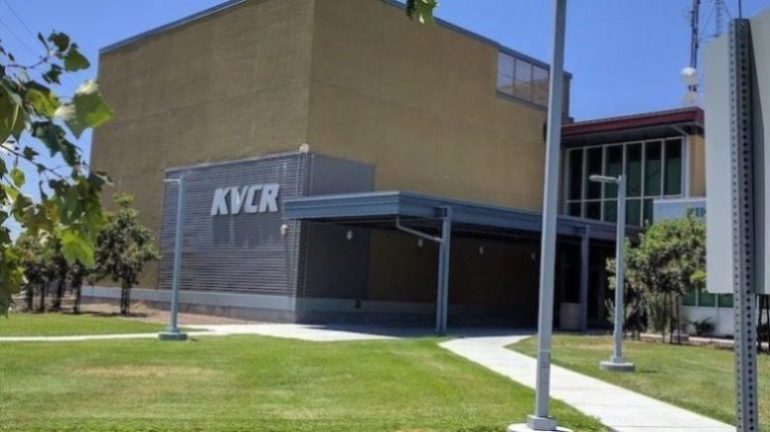Florida stations expand reach of public safety network

FPREN
FPREN host Tom Hudson and senior meteorologist Megan Borowski at work in 2023, during live hurricane coverage that originated from WUFT in Gainesville.
The Florida Public Radio Emergency Alert Network is introducing an AI-driven technology for transmitting government alerts and advisories via broadcast signals to its toolkit of public safety communications.
Developed, deployed and tested by WUFT in Gainesville with support from Florida’s Division of Emergency Management, BEACON combines public safety messages from local, state and federal agencies into a continuous audio feed of alerts distributed by broadcast, mobile and web-based platforms. The acronym stands for Broadcast Emergency Alerts and Communications Operations Network, a nod to the resilience and efficiency of broadcast facilities in delivering life-saving information during natural disasters.
“It’s a 24-hour, always-on alerting channel … providing a direct broadcast, mobile app and streaming conduit directly from government public safety and emergency management agencies to the public,” explained Randy Wright, executive director of the University of Florida’s College of Journalism and Communication Division of Media Properties, which operates WUFT. The station is also home to FPREN, which produces coverage of weather, safety and evacuation information during hurricanes and other emergency events. The service, which launched in 2013, airs statewide on Florida’s public stations.

News directors at both stations say the new tactics respond to misinformation that emerged and circulated during Hurricane Helene, which made landfall in Florida Sept. 26, 2024.
Newsrooms at some FPREN stations have also refined their strategies for making local coverage of weather emergencies more accessible on web-based platforms. During last year’s relentless hurricane season, WUSF in Tampa began publishing Spanish-language digital news coverage and a text-only version of its website, for example. WJCT in Jacksonville introduced a push-notification service for users who sign up for updates.
“You see a lot of people posting things to get clicks, and that’s like organizations that are out there trying to make money off the disaster,” explained Julio Ochoa, WUSF editorial director. The misinformation campaigns targeted Florida’s Hispanic and Latino communities.
Ochoa has also seen elected officials sharing misinformation. “That’s maybe the hardest to contradict or deal with,” he added.
‘A broadcaster and journalist’s best friend’
WUFT and its partners are working to implement BEACON on FPREN stations before the peak of the 2025 hurricane season. WLRN in Miami launched the service on its HD3 channel May 30, Wright said during the Public Media Business Association conference in Tucson. WGCU in Fort Myers was scheduled to launch BEACON next.
WUFT developed BEACON in collaboration with Futuri, a software development company specializing in AI technology, and FDEM. When local, state or federal agencies issue alerts or advisories into BEACON, its AI technology translates the text into voice messages that can be distributed via broadcast, mobile or web streams.
FDEM provided $3.1 million to develop and deploy the system and one year of operational support in 2024. The funds covered testing by FPREN, including during Hurricanes Helene and Milton last fall, Wright said during an interview. At that point, BEACON ingested alerts and advisories via the Federal Emergency Management Agency’s Integrated Public Alert and Warning System and transmitted them into a test audio stream.
“Beacon is, frankly, a broadcaster and journalist’s best friend, providing listeners and users with direct access to the official alerts while the journalists and broadcasters do their work in an unfettered manner on the primary broadcast signal,” Wright explained. Depending on the emergency situation and their capacity to report news coverage, each host station has the option of transmitting Beacon’s messages on its primary signal.
WUFT launched the beta site for the first BEACON broadcast to Gainesville-Ocala last December. WUFQ, its station in Cross City, now broadcasts the Beacon signal 24 hours a day, according to Wright.
“It’s been of great use and service with numerous severe weather outbreaks, road closures, etc., since that time,” Wright said. Rollout plans include FPREN stations in Pensacola, the Florida Keys, and other markets.

Right now, Wright’s top priority is launching BEACON for FPREN stations before the peak of the 2025 hurricane season. But he believes public stations in other states will see value in adopting the technology for their own public safety services.
“The system can be used to alert listeners to all different types of public safety issues, ranging from severe weather to chemical spills, active assailants, school closures and accidents causing highway and road issues,” he said. “Literally any type of alert or advisory is what BEACON is all about, and it functions just as well with all of them.”
Reaching digital audiences
Stations that launched new digital platforms for delivering news coverage last fall have also expanded those efforts. WUSF posts all of its news coverage on its text-only site. The Spanish-language news site, WUSF Noticias, combines daily news coverage with stories about preparing for hurricanes.
The goal is for Noticias to reach communities that are most targeted by disinformation with coverage that people will discover via Google search, Ochoa said.
WUSF is also working to reach audiences who rely on digital devices and social media for news, focusing mainly on Instagram Reels. “Reels are especially popular with the younger generations, and we are actively trying to reach this audience,” Ochoa said.
WUSF’s reporters received more training on how to produce Reels last year, and their videos on hurricane coverage got great traffic, Ochoa said. “Since we saw big spikes in our traffic on the videos we published during the hurricanes, we have since made the production of social media reels a part of our daily workflow.” Now a reporter produces social media videos full time.
When ‘Wi-Fi is not an option’
WUSF also continues to post all of its news coverage on its text-only site.
“During Hurricane Helene, we recognized that people were struggling to access information on our website because power was out across large swaths of our coverage area, so Wi-Fi was not an option and many cell towers were down,” explained Ochoa.

The text-only website, which WUSF worked with NPR to launch after Hurricane Helene, succeeded in attracting web visitors during Hurricane Milton, Ochoa said. “We have good feedback. Some people still had problems loading the text-only website, but at least it was quicker than the other websites.”
WJCT adopted another web-based technology for sharing verified and reliable information during natural disasters — pop-up notifications sent to web users’ desktop computers and mobile phones. A pop-up notification on WJCT’s website last year invited visitors to sign up for browser notifications that appear on their desktop computers and mobile phones.
The notifications were effective in distributing news and information last fall, according to Editorial Director Jessica Palombo. One shared a breaking news story about an evacuation order for St. Augustine, a coastal city about 40 miles south of Jacksonville, before Hurricane Milton made landfall. The story attracted more than 259,000 views, setting a record for WJCT’s digital coverage, Palombo said.

“Misinformation is actually a clear issue in our market,” she said. Achieving page views in the six figures was a breakthrough for WJCT and demonstrated demand for trusted and verified information.
“The notification played a part in that, but it was also a big piece of news,” she added. “We were also among the first outlets to report that.” WJCT also pushed the story to the News Break app, the platform that aggregates local news coverage.
These new strategies and tools for delivering public safety information are one part of the response to the spread of disinformation, Palombo said, because declining trust in news media contributes to the spread of disinformation. Public stations have to earn their audience’s trust through their regular coverage. “They’re not just going to suddenly find you when a storm happens,” Palombo said. The work of gaining listeners’ trust happens “being trustworthy 365 days a year.”







